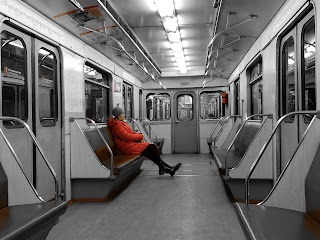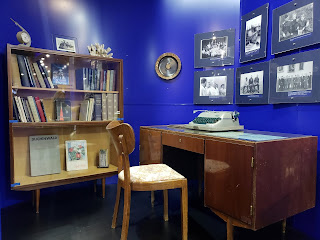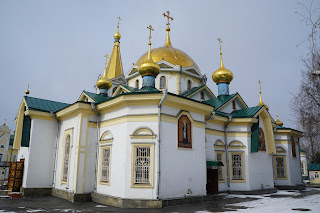Yelets
is almost 400 kilometers south of Moscow, now in Lipetsk oblast, and
has a population of a bit over 100,000 people. It was first mentioned
in historical documents in the 12th century, when it was a
fort for the princes of Ryazan.
Since
Yelets is south of Moscow, and was near the edge of Russian lands,
there is a lot of war in the history of the area. The Turks, the
Mongols, and more had interests in the land. During WW2 the Germans
captured the area for 6 days, in December of 1941.
No one
we know had been there previously, even the Russians we work with had
never heard of the place. (Russia is a HUGE country, this wasn't that surprising.)
Our
train arrived on time in Yelets, at 0430. This is not the world's
greatest time to arrive anywhere, but at least we were able to hang
out in the train station for a few hours.
I kept up my habit of finding a coffee machine and getting hot chocolate, so good and so cheap.
I kept up my habit of finding a coffee machine and getting hot chocolate, so good and so cheap.
The
train station itself wasn't big, but was nice. There were paintings
along the walls of the main waiting room, and a chandelier in the
middle of the ceiling. Plus, it was a good temperature, which is
surprisingly important when you're just waiting and waiting.
Around
0830 we started walking. Unlike many Russian towns, the train station
in Yelets does not sit at the end of a street leading to the center
of town.
We had to walk to the end of the tracks, cross over and walk a driveway of sorts to get to a street. The street took us under a bridge, and didn't have a good pavement on the side on which to walk.
We had to walk to the end of the tracks, cross over and walk a driveway of sorts to get to a street. The street took us under a bridge, and didn't have a good pavement on the side on which to walk.
Our
first stop was a war memorial for the Soviet fight in Afghanistan,
from 1979 to 1989. The memorial included tanks, and a mention of
military intelligence. Oddly enough, the military intelligence part
also looked like batman.
From
there we walked to a main street that took us to a couple bridges
going over the Bystraya Sosna River.
The river isn't big, one of the bridges is pedestrian, the other is vehicular. At the end of the pedestrian bridge is a tank memorial, for the 150th tank brigade in WW2. Nothing fancy, just a tank with a sign in the shape of a star.
The river isn't big, one of the bridges is pedestrian, the other is vehicular. At the end of the pedestrian bridge is a tank memorial, for the 150th tank brigade in WW2. Nothing fancy, just a tank with a sign in the shape of a star.
The
pedestrian bridge was lined with locks of love. As always, I wonder
how many of these couples are still together, and how long ago the
locks were placed on the bridge. I loved the bridge, or maybe just
the geometric lines of the engineering.
On the
other side of the bridge we found Victory Square. It was a WW2
memorial. There were plinths of specific people with 3D profiles
looking in different directions. It wasn't a big area, but it was
really respectful, and easily visible to every person who drives by.
We
kept going, heading for a museum. We found the museum of lace, but we
couldn't find an entry door. I read the listing online, and the sign
on the gate, and found a phone number. It turns out the museum is
actually a private home, or something like that, and the owner shows
people around his collection when you get ahold of him.
I sent a text to the number, but never got a response. Too bad, because the museum would've fit really well on our quirky museums list.
I sent a text to the number, but never got a response. Too bad, because the museum would've fit really well on our quirky museums list.
Just
across the street was an abandoned church. At least it looked
abandoned, because what we could see of it above ground was falling
down. We found a door, and were able to go in. We already had our
headscarves on, we had to put on wraparound skirts as well.
In
what I think was the basement was a small room with an iconostasis,
there was a celebration/ceremony taking place.
Neat to see, but since we didn't understand what was being said, it wasn't super interesting. We watched for a couple minutes, then left.
Neat to see, but since we didn't understand what was being said, it wasn't super interesting. We watched for a couple minutes, then left.
Oddly
enough, at the back side of this church was a bell tower that looked
brand new, at least the paint job looked new. I wonder if there is a
plan to eventually rebuild the full church?
A
couple blocks up the street from this church was Lenin Platz. Not
surprisingly, there was a statue of the man on one side of the platz,
we took our standard team picture. I liked the patterning of the
bricks on the square, it was at the end of a pedestrian street.
Since it was only a little over 10am, the square was really quiet.
Since it was only a little over 10am, the square was really quiet.
We
found a tiny cafe/store really close by, we stopped in to try
homemade donuts. Heated up and with powdered sugar on top, yum. Were
any of us hungry, not at all. But they were still good and totally
worth it.
We
walked down the two blocks of the pedestrian street and turned right.
A couple blocks away we could see the biggest church in town,
Ascension Cathedral. It's really big, and perched on the side of the
river, we had first seen it when we crossed the bridge.
The
church was designed by the same guy who designed the kremlin in
Moscow, and the Cathedral of Christ the Saviour in Moscow, or so I'm
told by my guidebook. It is yellow, with blue domes on top, and some
fancy gates on the end of the property.
We
entered and I was impressed from the very beginning. I am probably
not right, but it seemed like there were two sections, one older and
one newer. We entered into the newer section, which also had a very
high ceiling and great frescoes painted everywhere.
The older section was much the same, in that it also had beautiful frescoes and a high ceiling. The iconostasis was really fancy, and there were icons all over. We took our time walking through and exploring the church, it was really nice.
The older section was much the same, in that it also had beautiful frescoes and a high ceiling. The iconostasis was really fancy, and there were icons all over. We took our time walking through and exploring the church, it was really nice.
Across
the street from the church was a stelae with a gold double headed
eagle on top. The stelae is one you can find in each official city of
military glory in Russia. Very nice.
We
walked back to the pedestrian street, and back to Lenin Platz. On one
side was a restaurant called tomato.
We weren't super hungry, but we did want to kill some time. The pizza was okay, plenty big and plenty cheap.
We weren't super hungry, but we did want to kill some time. The pizza was okay, plenty big and plenty cheap.
We
walked out after another hour and some, and headed to a nearby park.
We saw a memorial to the civil service workers of the city, not
something very common. We went up the street to another church, the
Grand Ducal church of somebody and Alexander Nevsky. It was small,
but the interior was lovely. The stained glass was a mix of coloured
glass and paint on the clear glass. Really nice.
We
bought magnets from a little press stand, then went down the street
to a tall water tower.
I wonder if it is still used, or is just there because it looks nice. Further down the street was another church, this one also part new and part abandoned. Surprisingly, the abandoned part wasn't blocked off at all. There were steps going up into the bell tower, not blocked off. I wanted to go up, and I'm a risk taker for these things, but the tower did not look stable, so I didn't.
I wonder if it is still used, or is just there because it looks nice. Further down the street was another church, this one also part new and part abandoned. Surprisingly, the abandoned part wasn't blocked off at all. There were steps going up into the bell tower, not blocked off. I wanted to go up, and I'm a risk taker for these things, but the tower did not look stable, so I didn't.
The
interior of the 'new' part of the church was small, with a low
ceiling. There must be another section that is bigger, or at least
has higher ceilings. A fair number of Orthodox churches I've visited seem to have two 'sanctuaries,' one in the basement, and the bigger one on a second floor.
Then
we started a long walk. It was supposed to be approximately 45
minutes, but with our normal photo taking stops along the way it was
over an hour. We stopped at a park with an eternal flame memorial,
there were also statues for other soldiers in the history of the
town. There was also an 'alley' of some kind, with Lenin at the end.
The
rest of our walk eventually brought us to an old plane, a Mig-25, at
the edge of town. It was set up in the middle of two roads, so
traffic was pretty steady. It was neat to see, I was really hoping we
would be able to go inside, but that wasn't possible. At the other
end of the display area was a city sign for Yelets, we took another
of our standard team photos.
We
tried to take a bus back into the city center, but weren't able to
figure out where to catch the bus. The sun started to come out, so
the walk back into town was quite nice. We saw a fire station, with a
really picturesque observation tower. The guidebook says a nice
firefighter might let you up the tower, but I didn't see an open door
or anyone around, so that didn't happen. Oh well.
We
walked back to the water tower, finding a statue of Ivan Bunin
nearby. We also found a cafe, very cute. Our drinks were good, and we
were enjoying our time until a nearby group pulled out a guitar and
starting playing/singing. Argh.
We
went back to the restaurant called Tomato, as we needed to kill more
time before going back to the train station. Our food was good, but
we were totally put off by the screaming and running kids all over
the place. It was loud, we couldn't think, my parents never would've
let me behave that way. (Not that I would've thought to do so in the
first place.)
We
chose to walk over the vehicular bridge to cross the river, though I
regretted my decision when I stepped in a hole in the pavement on the
side. Thankfully I stepped straight down, and straight back out, I
didn't twist or break anything. Still, I was a bit freaked out and
was very careful about every other step to get to the other side of
the bridge.
The
rest of the walk to the train station was uneventful, as was our wait
in the train station. At one point a security guard asked to see our
tickets, he was making sure we weren't using the station as a free
hotel.
We
boarded our return train just after midnight, and arrived back in
Moscow just before 0800 on Sunday. Another lovely day/weekend trip :)


























































